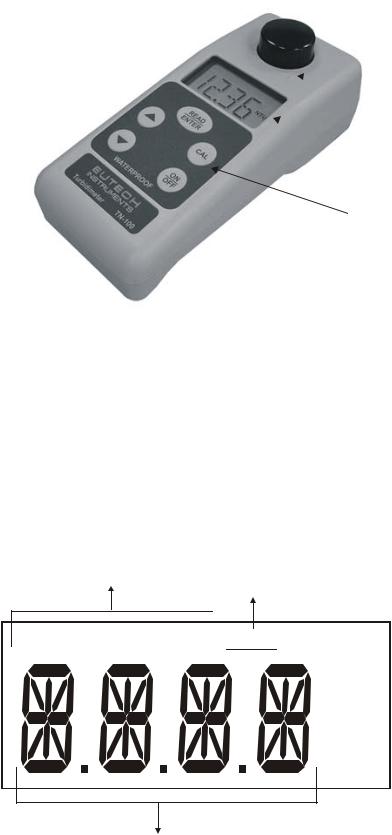Eutech instruments TN-100, T-100 Manual

Instruction Manual
TN-100/ T-100
Portable Turbidimeter
Technology Made Easy ...
68X357701
Rev. 1 10/03
Preface
This manual functions in two ways: first as a step by step guide to help you operate the waterproof TN-100/ T-100 turbidimeter; second, it serves as a handy reference guide.
It contains basic instructions that you must follow during the operation, care and maintenance of the instrument. The safety protection provided by this equipment may be impaired if it is used in a manner not described in this manual. It is recommended that all operators should read this manual prior to working with this instrument.
Eutech Instruments/ Oakton Instruments cannot accept any responsibility for damage or malfunction to the meter caused by improper use of the instrument.
The information presented in this manual is subject to change without notice as improvements are made, and does not represent a commitment on the part of Eutech Instruments Pte Ltd/ Oakton Instruments.
Note: Eutech Instruments Pte Ltd/ Oakton Instruments reserves the right to make improvements in design, construction, and appearance of our products without notice.
Copyright © 2003 All rights reserved.
Eutech Instruments Pte Ltd
Oakton Instruments
Rev. 1 10/03
TABLE OF CONTENTS
1 |
OVERVIEW ....................................................................................... |
1 |
|
|
1.1 |
Unpacking TN-100/ T-100 Meter and Accessories |
1 |
|
1.2 |
Display |
2 |
|
1.3 |
Keys and Functions |
3 |
|
1.4 |
Battery Installation |
4 |
2 |
TURBIDITY CALIBRATION.............................................................. |
5 |
|
|
2.1 |
Calibration Standards |
5 |
|
2.2 |
Indexing |
5 |
|
2.3 |
Calibration Procedure |
6 |
|
2.4 |
Restoring Factory Calibration |
8 |
3 |
TURBIDITY MEASUREMENT......................................................... |
10 |
|
|
3.1 |
General Information |
10 |
|
3.2 |
Turbidity Measurement Procedure |
10 |
|
|
3.2.1 Preparation of Sample Vial |
11 |
|
|
3.2.2 Measurement Procedure |
12 |
|
3.3 |
Single-Shot or Continuous Measurement |
13 |
4 |
TROUBLESHOOTING GUIDE........................................................ |
15 |
|
5 |
ROUTINE MAINTENANCE ............................................................. |
16 |
|
|
5.1 |
Vials – Handling, Cleaning and Care |
16 |
6 |
ACCESSORIES............................................................................... |
17 |
|
7 |
SPECIFICATIONS........................................................................... |
18 |
|
8 |
ADDENDUM 1: TURBIDITY ........................................................... |
19 |
|
|
8.1 |
Definition |
19 |
|
8.2 |
Why Is It Important? |
19 |
|
8.3 |
Measurement Principle |
19 |
|
8.4 |
Nephelometric Turbidity Units (NTU) |
20 |
|
8.5 |
Indexing a Vial |
20 |
9 ADDENDUM 2: GUIDE TO GOOD MEASUREMENT TECHNIQUE
21
|
9.1 |
Maintain sample vials in good condition |
21 |
|
9.2 |
Match Sample Vials |
21 |
|
9.3 |
Degassing |
21 |
|
9.4 |
Timeliness of Sample |
22 |
|
9.5 |
Other Important Sampling Techniques |
22 |
|
9.6 |
Calibration |
23 |
|
9.7 |
Dilution |
23 |
10 |
WARRANTY.................................................................................... |
24 |
|
11 |
RETURN OF ITEMS........................................................................ |
24 |
|

Instruction Manual |
TN-100/ T-100 |
1 OVERVIEW
Thank you for selecting the waterproof portable TN-100/ T-100 turbidimeter. The TN-100/ T-100 allows you to measure turbidity of an aqueous sample in the field. This instrument operates on the nephelometric principle of turbidity measurement and is designed to meet the criteria specified in ISO 7027 and DIN 27027 standards (see Measurement Principle on page 19).
1.1 Unpacking TN-100/ T-100 Meter and Accessories
The table below indicates the items that you should find in your turbidimeter shipment.
Item |
Quantity |
|
1. |
Field Portable TN-100/ T-100 Turbidimeter with 4 “AAA” |
1 |
|
batteries |
|
2. |
Instruction Manual |
1 |
3. |
Instrument Carrying Case |
1 |
4. |
Light Shield Cap |
1 |
5. |
Calibration Set (0.02, 20.0,100, 800 NTU Standards) |
1 |
6. |
Empty Vials |
3 |
7. |
Plastic bottle (empty – for collecting sample) |
1 |
8. |
Silicone Oil |
1 |
9. |
Lint free cloth |
1 |
Remove TN-100/ T-100 turbidimeter from the packing carton. Carefully inspect all items to ensure that no visible damage has occurred during shipment. If the items you received do not match your order, please contact your nearest distributor immediately.
WARNING: Extra care should be taken when unpacking, opening, and handling the calibration standards and sample vials. Surface scratches or finger smudges on the vial surface may cause measurement errors. Handle these items by their caps only.
Batteries provided with the meter package are to be installed prior to use.
See Section 1.4 - Battery Installation on page 4.
Figure 1 depicts the meter. The three main components of the instrument are the sample well, the display, and the keypad. The following sections will describe the functionality of the display and the keypad. The proper use of the instrument and the sample well will be discussed in later sections.
1

Instruction Manual |
TN-100/ T-100 |
 Sample Vial
Sample Vial
 Sample Well
Sample Well
 Index Mark
Index Mark
 Liquid Crystal Display
Liquid Crystal Display
Keypad
Figure 1: Parts of TN-100/ T-100 Turbidimeter
1.2 Display
All the LCD segments and annunciators that can appear on the display are shown in Figure 2. The display is used for reporting the turbidity reading and to provide guidance for the operation of the instrument. In addition, the display has several other annunciators that are used to communicate error messages and provide user guidance.
Calibration |
|
Standards |
Battery Indicator |
|
CAL 13 CAL 24 




 TAvg
TAvg
mg/l NTU  ppm %pH
ppm %pH
Units of
Measurement
14-segment Liquid Crystal Display
Figure 2: Customized LCD when switched on
2

Instruction Manual |
TN-100/ T-100 |
1.3 Keys and Functions
The keypad has five keys: ON/OFF, CAL, ▲, ▼, and READ/ENTER.
Keys |
Functions |
||
ON/OFF |
- Powers on and shuts off the meter. With the auto switch-off feature |
||
|
the meter automatically shuts off 20 minutes after last key press. |
||
CAL |
- Initiates the calibration mode of the meter. When pressed, the meter |
||
|
is set to accept the first calibration standard. |
||
|
- It is also used to exit the calibration mode if the user does not want |
||
|
to follow the complete calibration procedure. |
||
READ / |
- When in measurement mode, the READ/ENTER key is used to |
||
ENTER |
perform a measurement. |
||
|
- Single-shot measurements: When the key is pressed and released |
||
|
immediately (a quick key stroke of less than 0.3 seconds), the |
||
|
display will blink [-Rd-] for 10 times and then display the measured |
||
|
value. |
||
|
- Continuous measurements: If the READ/ENTER key is pressed and |
||
|
held, the instrument will perform a continuous measurement during |
||
|
which the display is updated every 2 seconds. This can be used for |
||
|
indexing vials. (This function is not available in calibration mode). |
||
|
After the READ/ENTER key is released, the instrument will |
||
|
automatically perform a single-shot measurement. |
||
|
- When in calibration mode, the READ/ENTER key is used to confirm |
||
|
the measurement for the calibration standards. |
||
▲and▼ |
- Active only during calibration mode. These keys are used to select |
||
|
the calibration point in an incremental/ decremental manner. |
||
|
NOTE: This meter is also fitted with an auto incrementing feature, i.e. |
||
|
after the successful calibration of one point it auto selects the next |
||
|
calibration point, or automatically exits the calibration mode after the |
||
|
fourth calibration point. |
||
|
|
|
|
READ
ENTER
CAL
ON
OFF
WATERPROOF
3

Instruction Manual |
TN-100/ T-100 |
1.4 Battery Installation
Four AAA-sized batteries are included in your meter’s packaging:
1.Use a Philips screwdriver to remove the two screws holding the battery cover. See Figure 3.
2.Remove the battery cover.
3.Insert the batteries. Follow the diagram inside the cover for correct polarity.
4.Replace the battery cover onto its original position using the two screws removed earlier.
5.The meter is now ready to operate.
Philips Screws
Battery cover
Four 'AAA'-sized batteries
Figure 3: Battery Installation
NOTE:
Dispose used batteries in accordance with your local regulations.
4

Instruction Manual |
TN-100/ T-100 |
2 TURBIDITY CALIBRATION
The TN-100/ T-100 turbidimeter was calibrated and tested prior to leaving the factory. Therefore, it is possible to use the instrument directly out of the box. However, re-calibration of the instrument is recommended to help you become familiar with the operation of the instrument and the calibration procedures. In addition, re-calibration is recommended at least once every month for optimum accuracy.
It is recommended that you perform a full calibration using all 4 standards provided to ensure full-range accuracy. However, the TN-100/ T-100 turbidimeter provides flexibility for you to calibrate at selected ranges suitable for your application.
In addition, the instrument comes with a light shield cap to shield off stray light during calibration and measurements.
2.1 Calibration Standards
We recommend that you use the following materials during calibration to achieve the accuracy stated in this manual:
CAL 1: 800 NTU Calibration Standard
CAL 2: 100 NTU Calibration Standard
CAL 3: 20.0 NTU Calibration Standard
CAL 4: 0.02 NTU Calibration Standard
It is well known that diluted Formazin is unstable. If you choose to use Formazin to calibrate the instrument, ensure that you are using a fresh stock suspension of Formazin to achieve the accuracy quoted for the instrument. Calibration standards offered are more stable than Formazin and have a limited shelf life of 12 months. If you use the supplied calibration standards to calibrate the instrument, review the expiration date (indicated on cap label) to ensure that the standards have not expired.
It is important that the calibration standards are not violently shaken or agitated because air entrapment in the fluid introduces an error factor during calibration which subsequently will lead to an inaccurate measurement.
2.2 Indexing
Due to the high quality of the glass vials provided, indexing is not required.
You only need to align the mark on the vial with the mark on the meter. However, in order to achieve a better accuracy of the measurement, you can proceed with indexing of the vials. See Section 8.5 - Indexing a Vial on page 20 for more information.
5

Instruction Manual |
TN-100/ T-100 |
2.3 Calibration Procedure
1.Place TN-100/ T-100 turbidimeter on a flat and level surface.
2.Select the calibration function of the instrument by pressing the CAL button once. The [CAL] annunciator will blink momentarily and the meter will prompt for the first calibration standard CAL 1 standard (800
NTU).
3.Insert the CAL 1 standard (800 NTU) into the sample well, aligning the mark on the vial with the mark on the meter. See Figure 10 on page 12.
4.Press down until the vial snaps fully into the instrument.
5.Cover the vial using the light shield cap.
6.Press READ/ENTER key.
7.The [CAL 1 800 NTU] annunciator will blink for about 12 seconds. When the instrument has completed calibration for this point, it prompts you to insert the next calibration standard into the sample well [CAL 2 (100 NTU).
8.Repeat the calibration sequence for each calibration standard.
9.After you successfully calibrate the CAL 4 standard (0.02 NTU), the display will show [STbY].
10.The meter is now ready to perform next measurement.
Figure 4 shows the complete calibration sequence.
NOTES:
1.If you wish to exit the calibration mode you may do so at the end of any step by pressing the CAL key. The meter will accept only the values calibrated prior to exiting.
2.You can skip a calibration point by pressing ▲ or ▼ keys and move on to the next calibration point.
3.After a successful calibration of one point, it will auto select the next calibration point. It will automatically exit calibration mode after the fourth calibration point.
4.If an error occurs during calibration, the display will present an error message. The meter will abort calibration and return to the measurement mode without saving the last calibration value.
5.For a list of error messages, refer to Section 4: Troubleshooting Guide on page 15.
6
